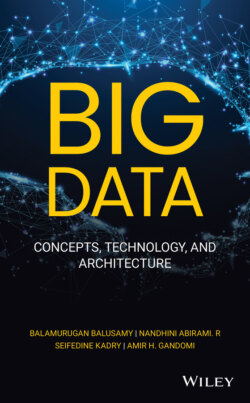Читать книгу Big Data - Seifedine Kadry - Страница 13
1.1 Understanding Big Data
ОглавлениеWith the rapid growth of Internet users, there is an exponential growth in the data being generated. The data is generated from millions of messages we send and communicate via WhatsApp, Facebook, or Twitter, from the trillions of photos taken, and hours and hours of videos getting uploaded in YouTube every single minute. According to a recent survey 2.5 quintillion (2 500 000 000 000 000 000, or 2.5 × 1018) bytes of data are generated every day. This enormous amount of data generated is referred to as “big data.” Big data does not only mean that the data sets are too large, it is a blanket term for the data that are too large in size, complex in nature, which may be structured or unstructured, and arriving at high velocity as well. Of the data available today, 80 percent has been generated in the last few years. The growth of big data is fueled by the fact that more data are generated on every corner of the world that needs to be captured.
Capturing this massive data gives only meager value unless this IT value is transformed into business value. Managing the data and analyzing them have always been beneficial to the organizations; on the other hand, converting these data into valuable business insights has always been the greatest challenge. Data scientists were struggling to find pragmatic techniques to analyze the captured data. The data has to be managed at appropriate speed and time to derive valuable insight from it. These data are so complex that it became difficult to process it using traditional database management systems, which triggered the evolution of the big data era. Additionally, there were constraints on the amount of data that traditional databases could handle. With the increase in the size of data either there was a decrease in performance and increase in latency or it was expensive to add additional memory units. All these limitations have been overcome with the evolution of big data technologies that lets us capture, store, process, and analyze the data in a distributed environment. Examples of Big data technologies are Hadoop, a framework for all big data process, Hadoop Distributed File System (HDFS) for distributed cluster storage, and MapReduce for processing.
